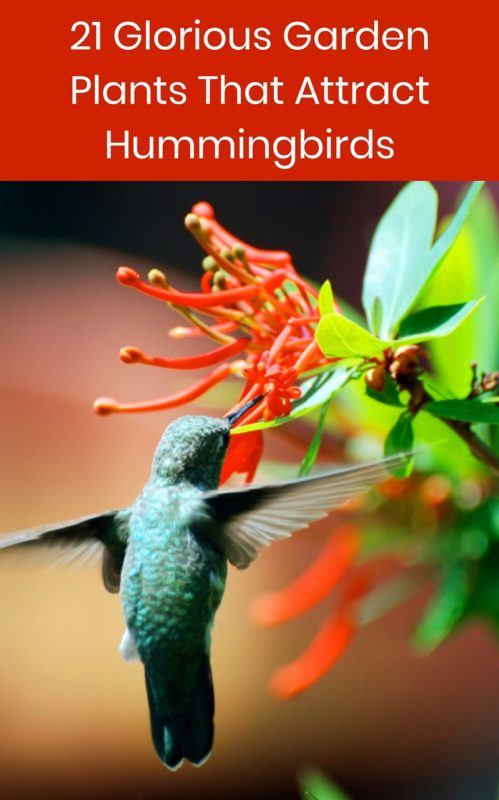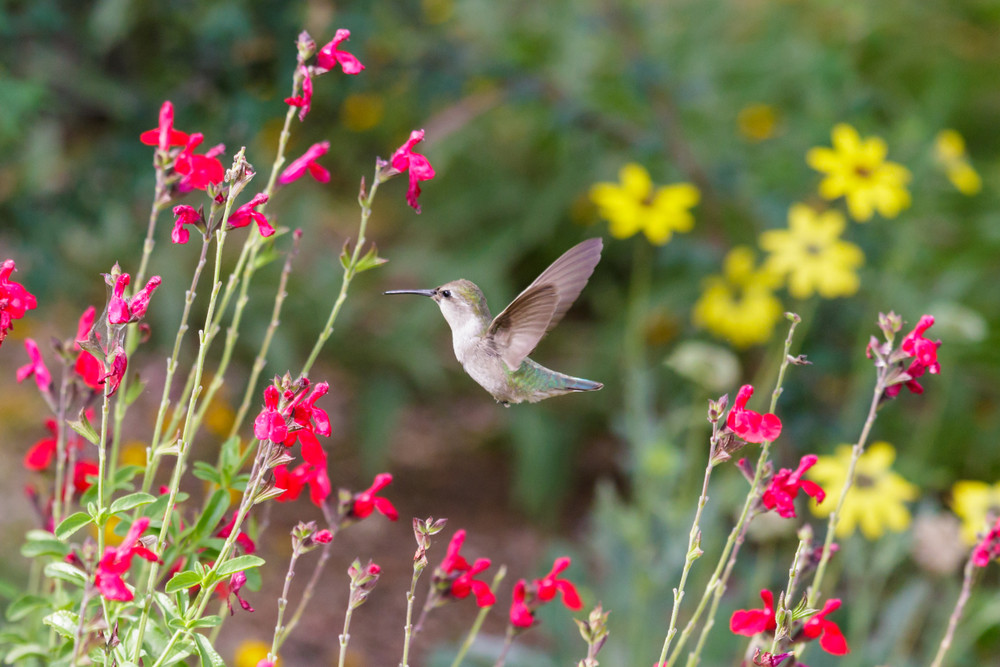
Hummingbirds are a delight to watch in any garden as they sprint from one flower to the next, performing some pretty amazing air acrobatics.
Inviting them into your garden is not all fun and games, however, as they are instrumental in pollination, making them a welcome visitor anytime.
Hummingbirds are attracted to the color red, but what really keeps them coming back to a particular garden spot is lots of flowers that produce nectar.
Tubular flowers have a special relationship with these birds probably because of parallel evolution. The deep neck of the flowers ensures that nectar seekers stay around long enough to pollinate them.
Only hummingbirds with long and narrow beaks and butterflies and moths with long feeding tubes can reach the nectar deep inside the corollary tube.
1. Bee balm – USDA Zones 4-9
No hummingbird can resist the sight of the red-flowered bee balm in all its summer glory. Their tubular flowers hold nectar that cannot be easily accessed by many other nectar lovers, so hummingbirds have a distinct advantage. Grow these native perennials in your garden, preferably in large groupings.
Although they are easy to grow, bee balm prefers slightly moist and very rich soil. Plant them in an area that receives plenty of sunlight or a partly shaded area in a very warm climate.
Not only the red flowered varieties but also the pink and purple ones have nectar, so don’t be hesitant to plant a wide variety. Remove spent flowers and prune plants after the first burst of flowers to encourage another bout.
2. Salvia – USDA Zones 8-11
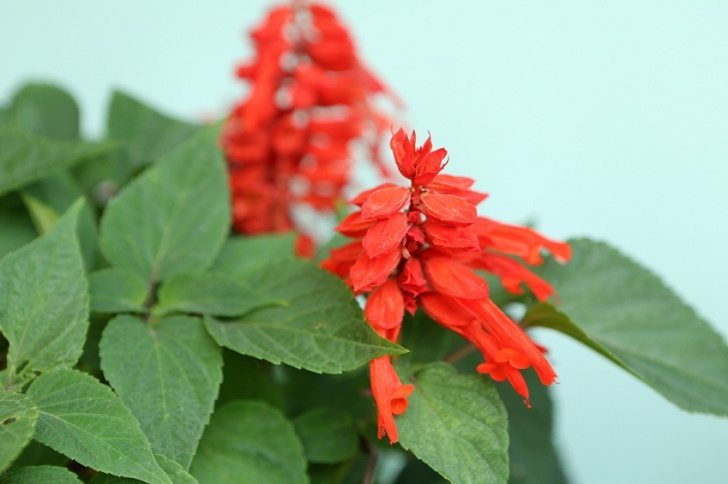
The brightly colored blooms of salvia offer plenty of sweet nectar for hummingbirds who flock to their tubular flowers. Red salvia may be the favorite, but you will see hummingbirds feasting on the pink and purple types as well.
Salvia of all colors are easy to grow from seeds, most of them are self-seeding in the garden. Most varieties like average soil and a sunny or partly sunny location.
3. Cardinal flower (lobelia) – USDA Zones 3 -8
Cardinal flowers may have earned their name from another bird, but they are an excellent addition to any hummingbird garden.The 2 ft long flower spikes carrying bright red flowers stay well above the foliage, making them easily noticeable as well accessible to hummingbirds.
It is best to grow lots of these lovely flowers together in a group. They are easily raised from seed and from easy-to-care-for perennial clumps.
4. Coral Honeysuckle – USDA Zones 4-10
It’s not surprising that the pretty peach red blossoms of coral honeysuckle are attractive to hummingbirds. Many birds actually decide to set up house in large, rambling honeysuckle vines.
You can grow this plant from seeds or root cuttings. Once established and given a support to climb on, they happily produce flowers from late spring through summer without any kind of pampering. The plant is pretty drought tolerant as the name ‘sempervirens’ indicates. A winter pruning will help keep it in good shape.
5. Wild Columbine – USDA Zones 3-8
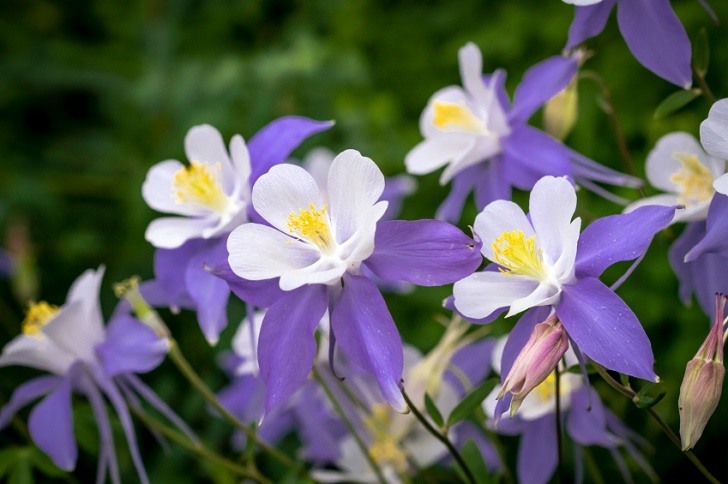
Hummingbirds may visit all types of columbines, but the beautiful, bicolor flowers of wild columbines are like magnets. Their brilliant color and an ample supply of nectar draw hummingbirds from far off into the garden.
The nectar spurs of the pendulous flowers are quite large, but more importantly, they are shorter and straight when mature. Hummingbirds prefer short and straight nectar spurs to the thin and long ones favored by certain moths.
Wild columbines are easily raised from seeds, and they self-seed freely, but they hybridize just as easily with other varieties of columbines.
6. Flowering tobacco – USDA Zones 6 -11
The lightly fragrant flowers of this tobacco species appear in summer, attracting hummingbirds to trumpet-shaped flowers. The birds have to dig deep to reach the nectar, but they don’t seem to mind. Apart from the white and light pink varieties commonly seen, there are beautiful dark pinks and magentas that may be more visually attractive to hummingbirds.
Flowering tobacco is a short-lived perennial in USDA Zones 10 and 11, but they can be easily raised from seeds and treated as annuals elsewhere. The flowers close or wither fast in summer heat, so grow them in partial shade in places having intense summers.
7. Weigela florida – USDA Zones 4-8
This floriferous shrub attracts a horde of hummingbirds and bees when it is in flower. It is a spring bloomer, but may bloom again in summer. Individual flowers are funnel shaped and look like the flowers of foxglove.
Flower color ranges from shades of pink and purple to deep magenta and red, with some cultivars carrying flowers of different color on the same plant. Some varieties have colorful or variegated leaves, such as the W. florida ‘Foliis Purpureis’ that has dark colored leaves and deep mauve flowers. Grow these large shrubs in a sunny spot for best results.
8. Cosmos – USDA Zones 3-10
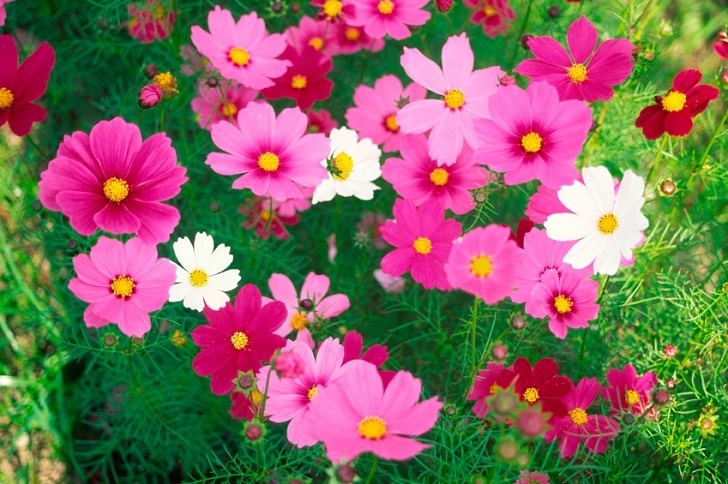
Cosmos can be found in beautiful shades of pink, yellow and orange. While hummingbirds will be attracted to these flowers, they love the ‘Ladybird Scarlet’ they best.
Cosmos are annuals that are easily grown from seed and have a long flowering season. They don’t need much maintenance, although deadheading will ensure more flowers. Grow cosmos in the garden along with other colorful, nectar-bearing flowers.
9. Hummingbird Petunia – USDA Zones 5-9
This is a petunia made-for-hummingbirds, or it would be more accurate to say that the flower and the bird are made for each other. These hummingbird-pollinated petunia flowers are bright scarlet in color, but they are not as large as the hybrids that are more commonly found in gardens. The exserta species has prominent stamens and produces more nectar than their modern counterparts.
Look for this particular variety to bring more wings to your garden. Hummingbirds are said to prefer them over their bright red feeders full of syrup.
10. Geranium – USDA Zones 9-11
Hummingbirds adore red geraniums but they will also feast on other colors such as peach and pink. If you plant some geraniums in pots around your back deck or patio, you will get a close up play-by-play of local hummingbirds. Unlike other birds, hummingbirds are social and quite friendly.
Geraniums can be propagated from cuttings, but allow the cut ends to dry out well for a day or two before sticking them in pot,
11. Yarrow – USDA Zones 3-9
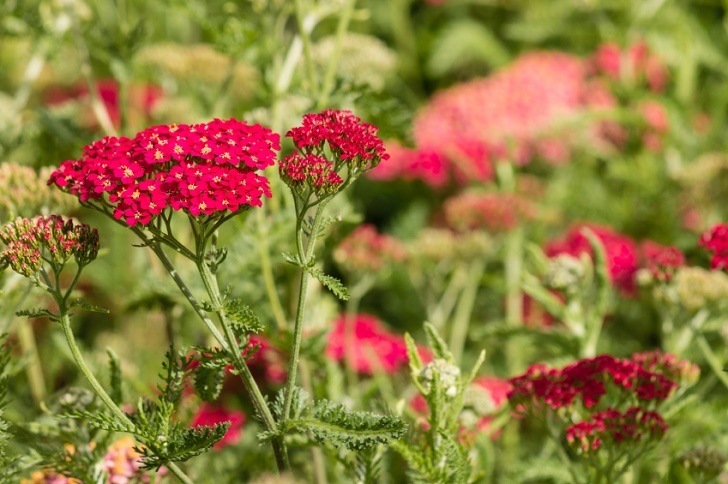
White and yellow-flowered yarrow may be common, but these lovely flowers come in many beautiful shades of pink and in bright red too. The large flower heads consisting of a multitude of small flowers attract both hummingbirds and butterflies.
Yarrow is so easygoing and drought tolerant that it has weed status in many areas. Give it a place in your hummingbird garden, but take precaution to keep it confined to the designated area if you wish to keep a “neat” garden look.
12. Hollyhocks – USDA Zones 3-10
Hollyhocks can add vertical interest to your flower garden and give it a quaint cottage garden feel.
What’s more, their tall stature makes it easy for the visiting hummingbirds to grab a meal without swooping too low. You can find hollyhocks in all kinds of colors but the darker, nearly red and burgundy colors work best to attract hummingbirds.
Although they are short-lived perennials, they put up a beautiful flower show during the 2-3 years they’re around. You can easily grow new plants from seeds.
13. Fuchsia – USDA Zones 7-9
The exotic looking fuchsia flowers come in jewel colors that attract hummingbirds. Not only that, they keep blooming from early spring until frost finally puts a stop to it. Fuchsias need at least half a day of sun to flower profusely.
Grow these popular plants in hanging baskets near windows so that you can watch the hummingbirds frequenting the flowers. Regular feeding and watering will keep these herbaceous perennials in good health.
14. Red hot poker plant – USDA Zones 5-9
These large, clump-forming plants are aptly named after their fiery red and orange flower clusters borne on long, sturdy flower stalks. Not only the flower color, but the nectar contained in them attracts hummingbirds from far and wide.
Kniphofia is easy to grow from seeds or divisions of clumps. There are many cultivars that flower at different times of the year, so growing several types ensures a continuous stream of flowers from early spring to late fall. Choose sunny, well-drained spots in the garden and plant them in spring.
15. Peacock flower (Caesalpinia pulcherrima) USDA Zones 8 -11
Butterflies and hummingbirds love this evergreen shrub when it is in flower. Select the orange-red variety to attract the winged beauties to your garden all through summer and fall.
If allowed to grow unchecked, the shrub can become a small, untidy tree. Prune it hard after a flush of flowering, and the new branches may bloom again. It may die down to the ground in frost-prone areas, but resurrects when warm weather arrives.
16. Orange trumpet flower – USDA Zones 4-9
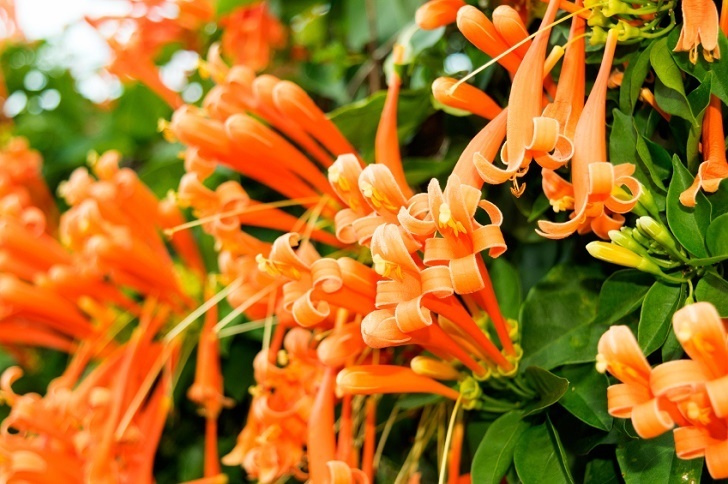
The peachy orange and yellow trumpet-shaped flowers of this perennial, woody vine contain nectar that lures hummingbirds and other honey suckers. Although this vigorous plant is considered invasive in some areas, frequent pruning and prompt removal of suckers can keep the growth and spread under control.
Plant it a bit away from the house, though, to prevent its roots damaging the walls, but give it a location where you can watch the hummingbirds feasting on the flowers. Cut back the vine after its summer flowering, and refrain from feeding it.
17. Abutilon – USDA Zones 6-9
The bell-shaped pendant flowers of abutilon or flowering maple, come in various colors, and resemble half opened hibiscus flowers although much smaller in size. Like hibiscus, they are tropical plants. They grow as perennials in USDA Zone 9 -11, but can be grown as annuals elsewhere.
Easily raised from seed, these fast-growing shrubs attract hummingbirds with their red, peach, orange and yellow flowers. You have the option of growing them in pots and overwintering them indoors as well.
18. Begonia – USDA Zones 6-9
Begonias are not usually considered hummingbird plants, but those with brightly colored blooms attract butterflies and hummingbirds, especially when grown in hanging baskets. Place hanging baskets in strategic locations that allow you to watch the winged beauties up close and personal.
Start your tuberous begonias early because it takes them up to 3 months to start flowering. Bring them out when all danger of frost has passed, and hang them up where they will get early morning sun. Keep them away from full sun, though. Too much heat can adversely affect this plant.
19. Penstemon – Zones 3 to 9
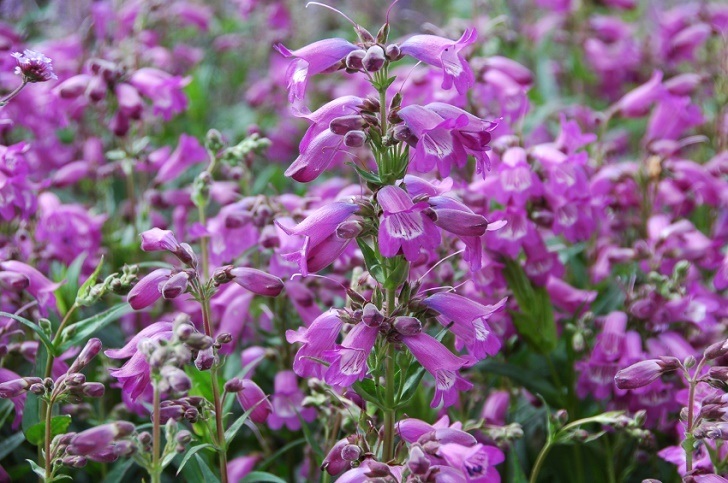
If you plant penstemons in you garden you can expect to have hummingbirds early in the season and keep them around till they depart in the fall. The red colored firecracker penstemons are early bloomers, so they can invite the birds in, but the pink-purple flowered Parry’s penstemon is equally attractive to them and will provide plenty of food throughout the growing season. Barbed penstemons provide a nectar source from late spring to early fall, but it is the cardinal penstemon that holds the sway throughout the hot months of summer.
Hummingbirds feast on penstemons of all color variations, so you can grow any of them, or all of them if you wish. They usually thrive on neglect, so once you plant them, they may come back year after year to delight your winged friends.
20. Coral bells – USDA Zones 3-8
Coral bells are grown for their beautiful foliage that adorns shade gardens as well as the airy mass of flowers held well above the foliage. The leaves may come in different colors and attractive shapes, but the flowers are usually in shades of pink, red and peach. Individual flowers are tiny, but the large spikes make them quite conspicuous.
If you have a shady garden, coral bells may be the best plant to bring in the hummingbirds. Pick from the wide variety of foliage and flower colors available and your local hummingbirds will be thrilled and well-fed.
21. Oriental poppies – USDA Zones 3-8
These stunning perennials with large, brightly colored flowers cannot escape anyone’s attention, let alone hummingbirds’. Depending on your area, they flower continuously from mid-spring to late summer.
Oriental poppies are easily raised from seed, and the clumps are long lasting, enlarging a bit every year without being overly aggressive. The deep red and orange-red varieties like ‘Fireball’ may be your best bet as far as hummingbirds are considered, but the purple, pink and peach flowered ones are also worth having. Grow them in a sunny spot where their silky petals can catch the light and reflect it.
Of course, be sure to offer plenty of water in and around your hummingbird garden. Plant a wide variety of flowers for best results. Keep in mind that larger plantings create a more alluring impact on hummingbirds and butterflies rather than a single plant here and there. Scatter wildflowers in with the above-mentioned flowers for a complete hummingbird buffet!
Pin This To Save For Later
